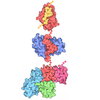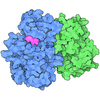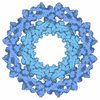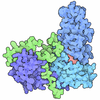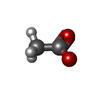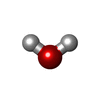[English] 日本語
 Yorodumi
Yorodumi- PDB-6y9s: Crystal structure of GSK-3b in complex with the imidazo[1,5-a]pyr... -
+ Open data
Open data
- Basic information
Basic information
| Entry | Database: PDB / ID: 6y9s | ||||||
|---|---|---|---|---|---|---|---|
| Title | Crystal structure of GSK-3b in complex with the imidazo[1,5-a]pyridine-3-carboxamide inhibitor 16 | ||||||
 Components Components | Glycogen synthase kinase-3 beta | ||||||
 Keywords Keywords |  TRANSFERASE / TRANSFERASE /  GLYCOGEN SYNTHASE KINASE-3 BETA / GLYCOGEN SYNTHASE KINASE-3 BETA /  INDAZOLE / INDAZOLE /  INHIBITOR / INHIBITOR /  KINASE / PROTEROS BIOSTRUCTURES GMBH KINASE / PROTEROS BIOSTRUCTURES GMBH | ||||||
| Function / homology |  Function and homology information Function and homology informationregulation of microtubule anchoring at centrosome / negative regulation of glycogen (starch) synthase activity / neuron projection organization / negative regulation of mesenchymal stem cell differentiation / beta-catenin destruction complex disassembly / negative regulation of type B pancreatic cell development / superior temporal gyrus development / positive regulation of protein localization to cilium / negative regulation of glycogen biosynthetic process / negative regulation of dopaminergic neuron differentiation ...regulation of microtubule anchoring at centrosome / negative regulation of glycogen (starch) synthase activity / neuron projection organization / negative regulation of mesenchymal stem cell differentiation / beta-catenin destruction complex disassembly / negative regulation of type B pancreatic cell development / superior temporal gyrus development / positive regulation of protein localization to cilium / negative regulation of glycogen biosynthetic process / negative regulation of dopaminergic neuron differentiation / maintenance of cell polarity / positive regulation of protein localization to centrosome / : / positive regulation of mitochondrial outer membrane permeabilization involved in apoptotic signaling pathway / positive regulation of cilium assembly / negative regulation of protein acetylation / APC truncation mutants have impaired AXIN binding / AXIN missense mutants destabilize the destruction complex / Truncations of AMER1 destabilize the destruction complex / beta-catenin destruction complex /  tau-protein kinase / CRMPs in Sema3A signaling / heart valve development / regulation of microtubule-based process / regulation of protein export from nucleus / Beta-catenin phosphorylation cascade / Signaling by GSK3beta mutants / CTNNB1 S33 mutants aren't phosphorylated / CTNNB1 S37 mutants aren't phosphorylated / CTNNB1 S45 mutants aren't phosphorylated / CTNNB1 T41 mutants aren't phosphorylated / Maturation of nucleoprotein / cellular response to interleukin-3 / Wnt signalosome / negative regulation of protein localization to nucleus / negative regulation of TOR signaling / regulation of long-term synaptic potentiation / Disassembly of the destruction complex and recruitment of AXIN to the membrane / Maturation of nucleoprotein / AKT phosphorylates targets in the cytosol / negative regulation of calcineurin-NFAT signaling cascade / positive regulation of cell-matrix adhesion / regulation of axon extension / dopamine receptor signaling pathway / negative regulation of phosphoprotein phosphatase activity / regulation of dendrite morphogenesis / tau-protein kinase / CRMPs in Sema3A signaling / heart valve development / regulation of microtubule-based process / regulation of protein export from nucleus / Beta-catenin phosphorylation cascade / Signaling by GSK3beta mutants / CTNNB1 S33 mutants aren't phosphorylated / CTNNB1 S37 mutants aren't phosphorylated / CTNNB1 S45 mutants aren't phosphorylated / CTNNB1 T41 mutants aren't phosphorylated / Maturation of nucleoprotein / cellular response to interleukin-3 / Wnt signalosome / negative regulation of protein localization to nucleus / negative regulation of TOR signaling / regulation of long-term synaptic potentiation / Disassembly of the destruction complex and recruitment of AXIN to the membrane / Maturation of nucleoprotein / AKT phosphorylates targets in the cytosol / negative regulation of calcineurin-NFAT signaling cascade / positive regulation of cell-matrix adhesion / regulation of axon extension / dopamine receptor signaling pathway / negative regulation of phosphoprotein phosphatase activity / regulation of dendrite morphogenesis /  regulation of axonogenesis / establishment of cell polarity / regulation of axonogenesis / establishment of cell polarity /  tau-protein kinase activity / glycogen metabolic process / ER overload response / Constitutive Signaling by AKT1 E17K in Cancer / protein kinase A catalytic subunit binding / tau-protein kinase activity / glycogen metabolic process / ER overload response / Constitutive Signaling by AKT1 E17K in Cancer / protein kinase A catalytic subunit binding /  dynactin binding / dynactin binding /  NF-kappaB binding / Regulation of HSF1-mediated heat shock response / NF-kappaB binding / Regulation of HSF1-mediated heat shock response /  epithelial to mesenchymal transition / canonical Wnt signaling pathway / negative regulation of osteoblast differentiation / negative regulation of protein-containing complex assembly / positive regulation of autophagy / regulation of microtubule cytoskeleton organization / regulation of cellular response to heat / cellular response to retinoic acid / extrinsic apoptotic signaling pathway / negative regulation of extrinsic apoptotic signaling pathway via death domain receptors / extrinsic apoptotic signaling pathway in absence of ligand / presynaptic modulation of chemical synaptic transmission / epithelial to mesenchymal transition / canonical Wnt signaling pathway / negative regulation of osteoblast differentiation / negative regulation of protein-containing complex assembly / positive regulation of autophagy / regulation of microtubule cytoskeleton organization / regulation of cellular response to heat / cellular response to retinoic acid / extrinsic apoptotic signaling pathway / negative regulation of extrinsic apoptotic signaling pathway via death domain receptors / extrinsic apoptotic signaling pathway in absence of ligand / presynaptic modulation of chemical synaptic transmission /  excitatory postsynaptic potential / negative regulation of insulin receptor signaling pathway / positive regulation of protein export from nucleus / positive regulation of protein ubiquitination / Ubiquitin-dependent degradation of Cyclin D / hippocampus development / positive regulation of cell differentiation / GSK3B and BTRC:CUL1-mediated-degradation of NFE2L2 / peptidyl-threonine phosphorylation / Degradation of GLI2 by the proteasome / GLI3 is processed to GLI3R by the proteasome / positive regulation of protein-containing complex assembly / Degradation of beta-catenin by the destruction complex / tau protein binding / negative regulation of canonical Wnt signaling pathway / B-WICH complex positively regulates rRNA expression / excitatory postsynaptic potential / negative regulation of insulin receptor signaling pathway / positive regulation of protein export from nucleus / positive regulation of protein ubiquitination / Ubiquitin-dependent degradation of Cyclin D / hippocampus development / positive regulation of cell differentiation / GSK3B and BTRC:CUL1-mediated-degradation of NFE2L2 / peptidyl-threonine phosphorylation / Degradation of GLI2 by the proteasome / GLI3 is processed to GLI3R by the proteasome / positive regulation of protein-containing complex assembly / Degradation of beta-catenin by the destruction complex / tau protein binding / negative regulation of canonical Wnt signaling pathway / B-WICH complex positively regulates rRNA expression /  regulation of circadian rhythm / regulation of circadian rhythm /  beta-catenin binding / positive regulation of GTPase activity / beta-catenin binding / positive regulation of GTPase activity /  circadian rhythm / positive regulation of protein catabolic process / cellular response to amyloid-beta / Regulation of RUNX2 expression and activity / neuron projection development / positive regulation of neuron apoptotic process / positive regulation of proteasomal ubiquitin-dependent protein catabolic process / circadian rhythm / positive regulation of protein catabolic process / cellular response to amyloid-beta / Regulation of RUNX2 expression and activity / neuron projection development / positive regulation of neuron apoptotic process / positive regulation of proteasomal ubiquitin-dependent protein catabolic process /  p53 binding / presynapse / positive regulation of protein binding / insulin receptor signaling pathway / negative regulation of neuron projection development / p53 binding / presynapse / positive regulation of protein binding / insulin receptor signaling pathway / negative regulation of neuron projection development /  kinase activity kinase activitySimilarity search - Function | ||||||
| Biological species |   Homo sapiens (human) Homo sapiens (human) | ||||||
| Method |  X-RAY DIFFRACTION / X-RAY DIFFRACTION /  SYNCHROTRON / SYNCHROTRON /  MOLECULAR REPLACEMENT / Resolution: 2.03 Å MOLECULAR REPLACEMENT / Resolution: 2.03 Å | ||||||
 Authors Authors | Krapp, S. / Griessner, A. / Blaesse, M. / Buonfiglio, R. / Ombrato, R. | ||||||
 Citation Citation |  Journal: Molecules / Year: 2020 Journal: Molecules / Year: 2020Title: Discovery of Novel Imidazopyridine GSK-3 beta Inhibitors Supported by Computational Approaches. Authors: Buonfiglio, R. / Prati, F. / Bischetti, M. / Cavarischia, C. / Furlotti, G. / Ombrato, R. | ||||||
| History |
|
- Structure visualization
Structure visualization
| Structure viewer | Molecule:  Molmil Molmil Jmol/JSmol Jmol/JSmol |
|---|
- Downloads & links
Downloads & links
- Download
Download
| PDBx/mmCIF format |  6y9s.cif.gz 6y9s.cif.gz | 151.9 KB | Display |  PDBx/mmCIF format PDBx/mmCIF format |
|---|---|---|---|---|
| PDB format |  pdb6y9s.ent.gz pdb6y9s.ent.gz | 124.8 KB | Display |  PDB format PDB format |
| PDBx/mmJSON format |  6y9s.json.gz 6y9s.json.gz | Tree view |  PDBx/mmJSON format PDBx/mmJSON format | |
| Others |  Other downloads Other downloads |
-Validation report
| Arichive directory |  https://data.pdbj.org/pub/pdb/validation_reports/y9/6y9s https://data.pdbj.org/pub/pdb/validation_reports/y9/6y9s ftp://data.pdbj.org/pub/pdb/validation_reports/y9/6y9s ftp://data.pdbj.org/pub/pdb/validation_reports/y9/6y9s | HTTPS FTP |
|---|
-Related structure data
- Links
Links
- Assembly
Assembly
| Deposited unit | 
| ||||||||
|---|---|---|---|---|---|---|---|---|---|
| 1 | 
| ||||||||
| 2 | 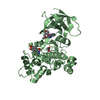
| ||||||||
| Unit cell |
|
- Components
Components
| #1: Protein |  / GSK-3 beta / Serine/threonine-protein kinase GSK3B / GSK-3 beta / Serine/threonine-protein kinase GSK3BMass: 39882.773 Da / Num. of mol.: 2 / Fragment: KINASE DOMAIN Source method: isolated from a genetically manipulated source Source: (gene. exp.)   Homo sapiens (human) / Gene: GSK3B / Production host: Homo sapiens (human) / Gene: GSK3B / Production host:   Spodoptera frugiperda (fall armyworm) Spodoptera frugiperda (fall armyworm)References: UniProt: P49841,  tau-protein kinase, tau-protein kinase,  non-specific serine/threonine protein kinase non-specific serine/threonine protein kinase#2: Chemical | #3: Chemical |  Acetate Acetate#4: Water | ChemComp-HOH / |  Water WaterHas ligand of interest | Y | |
|---|
-Experimental details
-Experiment
| Experiment | Method:  X-RAY DIFFRACTION / Number of used crystals: 1 X-RAY DIFFRACTION / Number of used crystals: 1 |
|---|
- Sample preparation
Sample preparation
| Crystal | Density Matthews: 2.7 Å3/Da / Density % sol: 54.46 % |
|---|---|
Crystal grow | Temperature: 277 K / Method: vapor diffusion / Details: 0.10 M TrisAc pH8.25 26 % PEG 8K 0.13 M NaCl |
-Data collection
| Diffraction | Mean temperature: 100 K / Serial crystal experiment: N |
|---|---|
| Diffraction source | Source:  SYNCHROTRON / Site: SYNCHROTRON / Site:  SLS SLS  / Beamline: X10SA / Wavelength: 0.99997 Å / Beamline: X10SA / Wavelength: 0.99997 Å |
| Detector | Type: DECTRIS PILATUS 6M / Detector: PIXEL / Date: Feb 23, 2017 |
| Radiation | Protocol: SINGLE WAVELENGTH / Monochromatic (M) / Laue (L): M / Scattering type: x-ray |
| Radiation wavelength | Wavelength : 0.99997 Å / Relative weight: 1 : 0.99997 Å / Relative weight: 1 |
| Reflection | Resolution: 2.03→65.67 Å / Num. obs: 50808 / % possible obs: 94.2 % / Redundancy: 2 % / Biso Wilson estimate: 41.797 Å2 / CC1/2: 0.997 / Rmerge(I) obs: 0.055 / Rrim(I) all: 0.074 / Χ2: 0.974 / Net I/σ(I): 9.63 |
| Reflection shell | Resolution: 2.03→2.28 Å / Redundancy: 1.9 % / Rmerge(I) obs: 0.448 / Mean I/σ(I) obs: 1.78 / Num. unique obs: 14391 / CC1/2: 0.771 / Rrim(I) all: 0.028 / % possible all: 91.4 |
- Processing
Processing
| Software |
| ||||||||||||||||||||||||||||||||||||||||||||||||||||||||||||
|---|---|---|---|---|---|---|---|---|---|---|---|---|---|---|---|---|---|---|---|---|---|---|---|---|---|---|---|---|---|---|---|---|---|---|---|---|---|---|---|---|---|---|---|---|---|---|---|---|---|---|---|---|---|---|---|---|---|---|---|---|---|
| Refinement | Method to determine structure : :  MOLECULAR REPLACEMENT MOLECULAR REPLACEMENTStarting model: NONE Resolution: 2.03→65.67 Å / Cor.coef. Fo:Fc: 0.957 / Cor.coef. Fo:Fc free: 0.938 / SU B: 6.563 / SU ML: 0.164 / Cross valid method: THROUGHOUT / σ(F): 0 / ESU R: 0.199 / ESU R Free: 0.179 Details: HYDROGENS HAVE BEEN ADDED IN THE RIDING POSITIONS U VALUES : REFINED INDIVIDUALLY
| ||||||||||||||||||||||||||||||||||||||||||||||||||||||||||||
| Solvent computation | Ion probe radii: 0.8 Å / Shrinkage radii: 0.8 Å / VDW probe radii: 1.2 Å | ||||||||||||||||||||||||||||||||||||||||||||||||||||||||||||
| Displacement parameters | Biso max: 170.44 Å2 / Biso mean: 41.632 Å2 / Biso min: 19 Å2
| ||||||||||||||||||||||||||||||||||||||||||||||||||||||||||||
| Refinement step | Cycle: final / Resolution: 2.03→65.67 Å
| ||||||||||||||||||||||||||||||||||||||||||||||||||||||||||||
| Refine LS restraints |
| ||||||||||||||||||||||||||||||||||||||||||||||||||||||||||||
| LS refinement shell | Resolution: 2.03→2.083 Å / Rfactor Rfree error: 0 / Total num. of bins used: 20
|
 Movie
Movie Controller
Controller


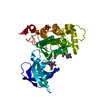




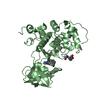





 PDBj
PDBj